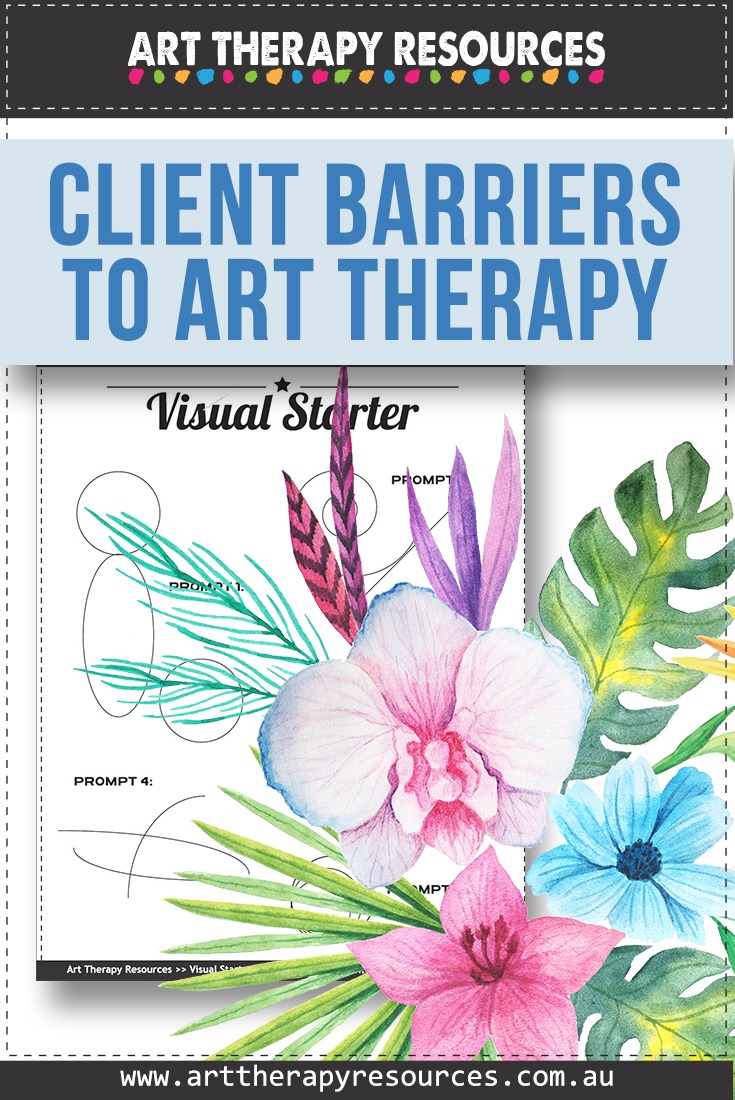THIS POST INCLUDES:
1. What are Client Barriers
2. Client Barriers to Therapy
3. Client Barriers to Art Therapy
4. Art Therapist Role
5. Free Art Therapy Exercise Download
WHAT ARE CLIENT BARRIERS
The main behavioural components of a client’s interaction in their therapy sessions involve:
- Initiating and attending therapy sessions
- Participating in therapy sessions
- Engaging in therapeutic work outside sessions
Client barriers will differ for adults and children as children are dependent on parents/caregivers to initiate and attend therapy.
Children may also lack the developmental maturity to resist interference and negative behaviours from parents/caregivers regarding the effectiveness of therapy.
CLIENT BARRIERS TO THERAPY
There are many reasons why clients put up barriers to therapy. Below are some of the barriers you may experience at the various stages of therapy treatment with your clients:
INITIATING AND ATTENDING THERAPY
- Stigma associated with admitting a mental health issue
- Misunderstanding the process of therapy
- Unsure of the benefits of therapy
- Financial limitations/lack of insurance
- Access problems including transport
- Communication problems affecting making and receiving contact
- Availability due to work obligations
- Family obligations
- Threats of violence from partner for seeking help
- Custody conflicts for children attending
- Child who rely on parents/caregiver for attendance
PARTICIPATING IN THERAPY SESSIONS AND DOING WORK OUTSIDE OF SESSIONS
- Children guilt over discussing abusive parent/caregiver
- Additional stress placed on family dynamics
- Effect on marital or relationship dynamics
- Isolation from family members who disapprove of therapy
- Stigma associated with receiving mental health services
- Self-defeating behaviours
- Defensiveness over mental health issues
- Level of readiness for change
- Cultural differences (language, values, beliefs)
- Psychological comorbidity (eg. substance abuse, anxiety)
- Developmental and intellectual functioning
- Poor therapeutic alliance with therapist
- Therapist providing ineffective treatment
- Therapists not suited to client’s specific mental health needs
- Distracting therapy location
CLIENT BARRIERS TO ART THERAPY
In addition to the psychological barriers to therapy, clients may also experience barriers to engaging in art therapy with a specific resistance to art activities.
Some of the barriers you may experience from a client to undertaking art activities include:
- Clients belief they lack skills in art making
- Clients fear of failure and receiving judgment
- Unfamiliarity with the process of art making
- Unfamiliarity with the process of art supplies
- Resistance to trying new things (eg. art making)
- Resistance to texture or smell of art supplies
- Physical limitations using art supplies
- Cognitive impairments such as dementia
ART THERAPIST ROLE
When working with your client, it’s important to determine the types of barriers your client may be facing.
First, you should determine if your client is experiencing any physical or financial limitations in attending therapy sessions at your location.
Attending therapy is your client’s responsibility, however, you may be able to assist your client by providing flexible access to your sessions. You may also be able to assist with any self-defeating attitudes around the benefits of therapy.
If your client is experiencing pressure from outside relationships such as a parent, partner or other family members, you can engage in discussion with your client about these effects. Work with your client to create a strategy to minimize barriers.
If you feel your skill level is not suitable for your client’s needs, discuss other types of services with your client and facilitate a referral if necessary. You may also be able to provide information and access to other community resources for your client to help with transport, financial assistance and childcare assistance if required.
Use your website to publish articles, blog posts, videos and other media to explain your therapy process using your specific counselling approach. You can also provide information on the art therapy process and help address any possible barriers to your potential client engaging in art activities.
As an art therapist, your role is to help your client decrease intrusive feelings of anxiety when participating in the art process. You should use basic terms for art materials and techniques and encourage your client to explore the art supplies and activities that appear interesting to them when they attend each session.
At times it may appear that your client is using excuses to avoid attending therapy or engaging in art therapy activities. You may experience some frustration with what appears to be repeated disruptive or avoidance behaviours, however, it is important to facilitate discussion around perceived barriers and how you can work with your client to alleviate any concerns, anxiety or reluctance.
FREE DOWNLOAD: Art Therapy Exercise
Download this visual starter worksheet to help your client get started on an art activity.

BUILD YOUR ART THERAPY REFERENCE MATERIALS:
Pin this image to your Pinterest board.

SHARE KNOWLEDGE & PASS IT ON:
If you’ve enjoyed this post, please share it on Facebook, Twitter, Pinterest. Thank you!
